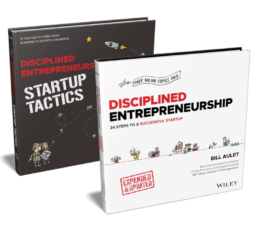The Disciplined Entrepreneurship Toolbox
Stay ahead by using the 24 steps together with your team, mentors, and investors.
The books
This methodology with 24 steps and 15 tactics was created at MIT to help you translate your technology or idea into innovative new products. The books were designed for first-time and repeat entrepreneurs so that they can build great ventures.

In 2013, when I wrote an OpEd piece for the Wall Street Journal their headline writers added the headline “Teaching Entrepreneurship Is in the Startup Phase.” Every year since then, we have learned so much and improved how we are teaching it. A summary of those lessons in the first six years after that piece was captured in an article I wrote in March 2019 before the pandemic – “What I’ve Learned About Teaching Entrepreneurship”. During the pandemic, entrepreneurship education took another very important dimension. We learned a lot more of what was needed in an increasingly turbulent world and the concept of antifragility came to the forefront. This was captured in a widely viewed and carefully crafted Antifragile speaker series as well as another article “Teaching Entrepreneurship, Cultivating Antifragility”. Thankfully, this evolution has been constantly moving the field forward because we need more and better entrepreneurs throughout society now more than ever and entrepreneurship education plays a central role in achieving this goal.
As we are now in 2024, my colleague Paul Cheek and I, believe there is another important step forward we should take that builds off all we have done so far and will get entrepreneurship education to the next level. This is the mental model of a three-tiered approach of “theory, practice, tactics”.
Theory: In a word, theory provides the “rigor” for teaching entrepreneurship. It casts a critical eye on any assertion and seeks evidence that it is true. The gold standard here is a “randomized control test” (RCT) which is extremely difficult to run in an entrepreneurial environment there can still be great value in a more scientific and observational role in developing and assessing entrepreneurship educational materials. This is often done via the “peer review” process to ensure a healthy unbiased perspective as well as sufficient rigor. Another critical part of the theory dimension is to be aware and build off previous work in the field. The goal should be to integrate new content into the already proven body of knowledge in the field and not reinvent already established principles.
Practice: In a word for practice, it brings “relevance” to the educational process. Through their deeply experiential involvement with entrepreneurship, they have a deep understanding of how this craft is done in the real world. Inherent knowledge gained from experience is of a different variety than observation. As is often said, “In concept, concept and reality are the same but in reality, concept and reality are often very different.” There is some deep understanding gained from doing entrepreneurship that is not sufficiently captured by observation and almost certainly never will. If you think of a sport like basketball, you may have some people who haven’t played basketball in the decision-making process but you would never have none in the decision-making process. The front-line coach always has the basketball-playing experience to interpret the instructions into action. Practitioner’s strength should be to help develop useful frameworks that are action-oriented to produce value. They may not be precisely correct but to the practitioner, the question is not whether a framework or first principles is correct, the question is whether it is useful. The practitioner’s role is to translate concepts into practice to create relevance with useful frameworks and first principles. The practitioner gone wrong tells individual personal stories that are not evidence-based on a broader scale so they miss the rigor. Another way a practitioner can go wrong is to seek absolute truth at the expense of what is useful. The analogy I often use is that Newton’s Physics is not precisely correct (that would be Einstein’s domain) but it is very useful and valuable in the real world most of the time (especially relative to Einstein’s Theory of Relativity). A pithy difference between practice and theory would be the following. “Peer-reviewed” in the case of academics, peers would mean other academics. If we apply the same concept to practitioners, “peers” would be the market.
Tactics: For tactics, the word that summarizes this aspect is “actionable”. Practice should provide frameworks and first principles but to implement them, tactical guidance is needed. Tactics is yet another extension down to a lower level to make this useful. And to be effective, it must be taught in an apprenticeship mode, frameworks, and first principles are not enough. We must teach people the details of implementation with tactics. For example, we can talk about the need for Primary Market Research in the levels above, but how do you do this? That is tactics. We talk about the importance of the Cost of Customer Acquisition as a first principle, but how do you implement a Facebook ad campaign? Actually, Facebook Ads are no longer the best way to drive down the Cost of Customer Acquisition, but the first principle still stands, so now we have to teach how to implement a TikTok ad campaign or some other tactic that will change. Again, the frameworks and the first principles may well not change but the tactics will. If the frameworks and first principles change, then that is the purview of the Practitioner and potentially the Academic but not the responsibility of the owner of the Tactics level.
We believe the best entrepreneurship education will include and integrate all three elements above. It is not new news that integrating theory and practice is fundamental to best practices. The cognizant dean at MIT Sloan for our center, Nelson Repenning, has said it well for years. “My classroom works best when we privilege neither theory nor practice, but instead make sure both are front and center, highlighting where they align and debating the relative merits when they don’t.” This has been and continues to be his mantra.
What we are adding to this specifically for entrepreneurship is that students want and we should provide as educators a third dimension as well, which is tactics. There is often a tension between these different elements, which is healthy. In the end, however, the key to success is balance. Having one is not at the expense of another but rather amplifies the value of the other elements. To advance the field, we need all three to work in harmony. The advancement of each element is essential for the critical continued advancement of the field. The individual advancement of each element can only be achieved more efficiently and effectively when working with the other two elements to provide perspective and new evidence. The future of entrepreneurship education is all three working together in a coordinated fashion to produce a final product that is rigor, relevant, and actionable.
The authors
Bill Aulet & Paul Cheek
Bill and Paul work together at the Martin Trust Center for MIT Entrepreneurship and both teach at MIT Sloan School of Management. In the spring of 2024, Bill published the new Disciplined Entrepreneurship: Expanded & Updated and Paul published the companion book Disciplined Entrepreneurship Startup Tactics.
Sign up for our newsletter
How relevant was this article to you?
Click on a star to rate it!
Average rating 4.7 / 5. Vote count: 10
No votes so far! Be the first to rate this post.
We are sorry that this article was not useful for you!
Let us improve this post!
Tell us how we can improve this post?


